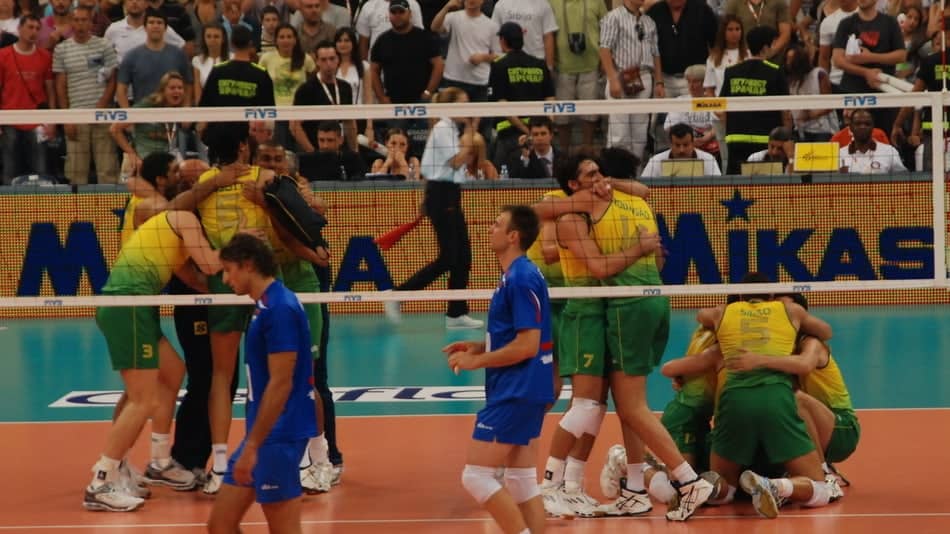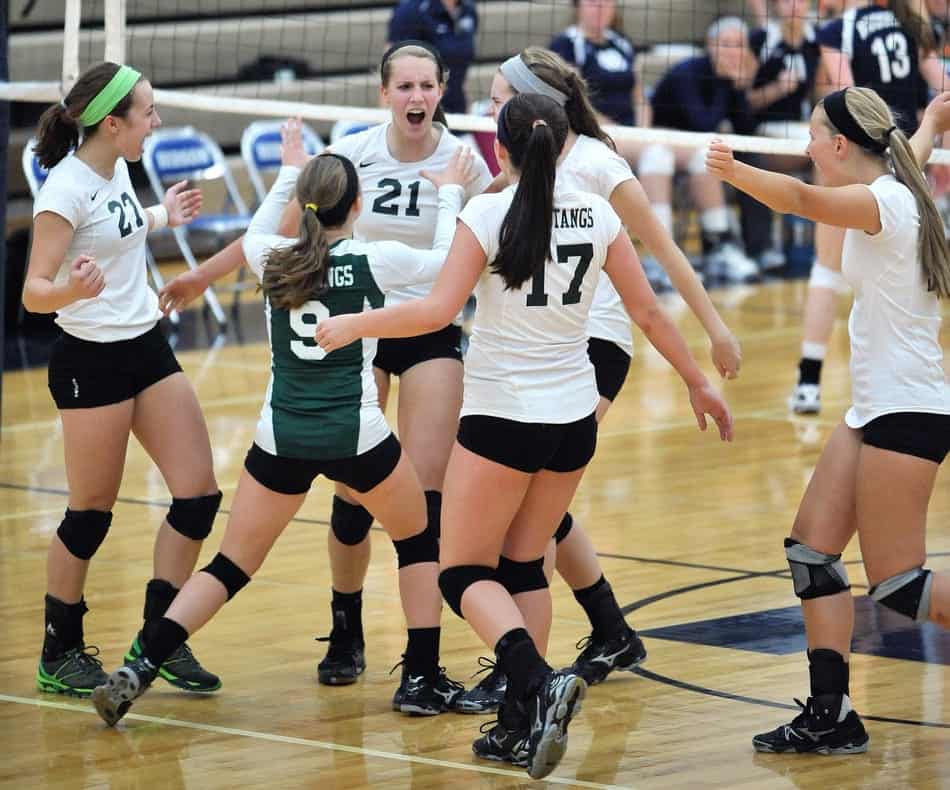When you’re new to volleyball there are so many different particular rules it can sometimes seem like the rules keep changing? At a tournament yesterday, I heard a parent (or possibly a grand-parent) ask this question, a question I’ve heard literally hundreds of times.
Is volleyball played to the best of 3 sets or the best of 5 sets? The rules change depending on the setting and situation, but we’ll walk you through all the answers in this article. Typically, younger age groups play the best 2 out of 3 sets, while high school varsity and older play the best 3 out of 5 sets.
What Does “Best of 3” or “Best of 5” Mean?
When you’re playing an opponent, the match is the entire meeting between the two teams. That match is going to be made up of a number of sets. So your team may win some of the sets, but lose the overall match and vice-versa.

When you divide the match into sets, to decide the winner, one of the teams must win the majority of the sets to win the match.
So when someone says, “Best of 3” or “Best out of 3”, they are referring to winning 2 out of 3 sets, which would mean winning the majority of the 3 possible sets.
In the same way, if your meeting is won by the best of 5 sets, 3 winning sets would make the majority and thus win the match.
In each case, when a team wins the necessary number, the match is ended, there is no point in playing the final sets. The extra time and energy would not be well-spent and would usually only be discouraging to the loser and boring to the winner. You would also be risking needless injury.
Is High School Volleyball Best of 5?
Rules may be changed depending on the rules of the particular league or tournament or even just the meeting.
Typically during regular-season games, varsity matches are played to the best of 5, but JV (Junior Varsity) games are usually played to the best of 3 sets. When you get into the sport you’ll see that usually at the JV level, the team that wins the first 2 sets is nearly always a strong enough team that playing another would be a waste of time and energy. You may see some rare occasions where a JV tournament final match will be decided by a “best of 5” match.
Of course statistically, at any level the odds of coming back to win the best of 5 after losing the first 2 are very low, it does happen. Volleyball is a quick and exciting sport where teams can go on streaks and ride momentum for long stretches of points. Playing a match to the best of 5 sets is good practice whenever possible because it produces a better representation of who really is the best team.
What Is a Tri-Match in Volleyball?
Sometimes teams will arrange a 3-way meeting to combine more games. So instead of having just 2 teams playing each other, you will have team A playing team B, then team A playing team C, and finally, team B will play team C.
This is not a tournament, so there will not be any more matches regardless of who wins or loses. These are treated as individual games on your regular-season record.

Why Would Teams Play A Tri-Match?
Usually, the benefit of playing a tri-match would be that you can reduce the travel time for some teams that are farther away. This is certainly a benefit for teams that are on the opposite outer boundaries of an area. We usually have 2 or 3 tri-matches per season with my daughter’s league so that the teams don’t have to make as many long-distance trips in a short time frame.
A second possibility would be to make up games that were canceled earlier in the season. If a match was canceled because of weather or an emergency situation, the coaches may have trouble rescheduling by the end of the season and may ask a third team to combine their meeting into a tri-match.
Disadvantages Of Playing Tri-Matches
When you play a tri-match, the biggest disadvantage is the amount of time that it takes. During the afternoon or evening, your team is going to play 2 matches and may also have to sit and take a break while the other 2 teams play, so it can be a long night.
Unless your facility has a separate gym where multiple games can be played at the same time, leagues and coaches will usually try not to schedule varsity and junior varsity tri-matches together. Sometimes teams will agree to begin the score at 4-4, which is a common way to shorten the time of a game that’s usually used in tournaments during pool play.
One of the ways teams will try to limit the impact of the extra playing time is that varsity teams will only play best of 3 instead of a full best of 5. This can be frustrating if the results are a highly competitive score in each of the 3 sets, but the tradeoff is that the players aren’t stuck playing all night.
Is College Volleyball Best of 3?
There may be exceptions to the rules in college volleyball just as well as in the other levels of the sport, but regular-season games for the NCAA are scheduled as the best 3 out of 5 sets.
Is Beach Volleyball Best of 3 or Best of 5?
Beach volleyball is designed to be a best of 3 format. The games go to 21 points instead of the 25 points used in indoor volleyball. The winning team has to lead by 2 points to win the set and there’s no limit. So the first team to lead by 2 after a total of 21, wins the set.

If the teams split the first two sets (meaning they each win 1), then the third set becomes a tie-breaker set and is only played to 15 points. Again the tie-breaker must be won by 2 points.
Would you like to learn more about Beach Volleyball? Check out our articles on the whole Beach Volleyball category.
What Does It Mean To Win or Lose In Straight Sets?
Winning or losing in straights simply means you won or lost all of the sets and are done more quickly. This is viewed as a decisive result whether you’re the winner or the loser.
If teams are fairly evenly matched in ability level, the sets can often go back and forth which means more sets will be played to determine the winner. Very evenly-matched teams will usually produce longer rallies as well, which means your match will really become extended.
What Is a Tie-Breaker Set?
A tie-breaker set is the third or 5 sets in a match after the teams have won an equal number of sets to get to the end.
In a tie-breaker set, the main difference is that the point total is lowered. Instead of having to win 25 points, the winning team only needs to get to 15 points with a 2 point advantage.
In most settings, your team will switch sides of the court after each set. This is in the interest of being fair. If there is some sort of advantage on one side or the other, the idea is that each team will enjoy that benefit an equal amount of time. So in most cases, during a tie-breaker set, the teams will switch sides once the first team reaches a score of 8.
Related Questions
What Is Rally Point Scoring?
Rally point scoring is a quicker game format than the old side-out scoring format. During rally point scoring every rally is worth a point, regardless of who served the ball.
Do you still have some questions about rally point scoring? Check out this article I wrote to learn all about it.
What Is A Rally In Volleyball?
A rally is every time the ball is served and put into play. The rally may be short if the ball is not returned, or it may be long if the teams play it back and forth over the net.
Resources:
https://www.fivb.org/TheGame/TheGame_BeachVolleyball.htm
http://www.ncaa.org/playing-rules/womens-volleyball-rules-game
Photo credits:
Feature image by Matt Pendleton on flickr.com: https://creativecommons.org/licenses/by-nd/2.0/, cropped to zoom.
Brazil vs. Serbia image by George Groutas on flickr.com: https://creativecommons.org/licenses/by/2.0/, cropped to zoom.
Mustangs image by K.M. Klemencic on flickr.com: https://creativecommons.org/licenses/by/2.0/, cropped to zoom.
Beach volleyball image by 2017 Canada Summer Games on flickr.com: https://creativecommons.org/licenses/by/2.0/, cropped to center.
Recent Posts
Athletes, listen up! Do you have a closet full of old jerseys, sweatpants, and tees that you just can't seem to part with? Well, dust them off, because you're sitting on a goldmine of fashion...
You may have heard, or you may have noticed, that there's been a change to the rule about double contact in volleyball. In 2022, an experimental rule change began to be implemented, where the double...
